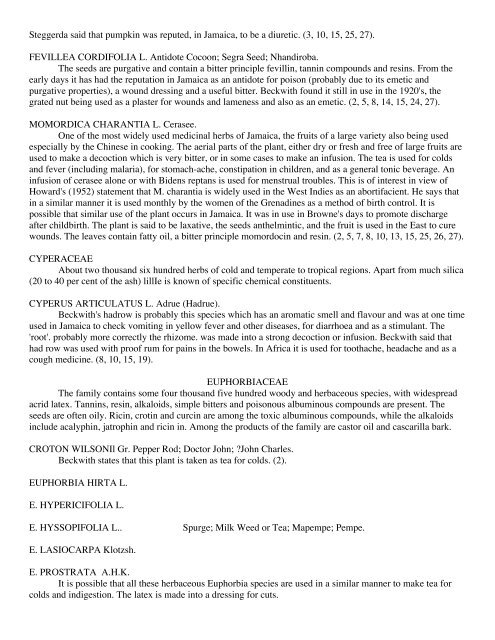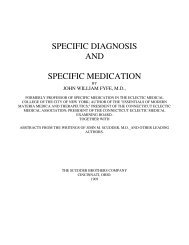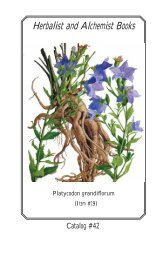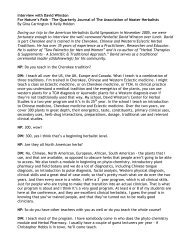MEDlCINAL PLANTS OF JAMAICA. PARTS 1 & 11.
MEDlCINAL PLANTS OF JAMAICA. PARTS 1 & 11.
MEDlCINAL PLANTS OF JAMAICA. PARTS 1 & 11.
You also want an ePaper? Increase the reach of your titles
YUMPU automatically turns print PDFs into web optimized ePapers that Google loves.
Steggerda said that pumpkin was reputed, in Jamaica, to be a diuretic. (3, 10, 15, 25, 27).<br />
FEVILLEA CORDIFOLIA L. Antidote Cocoon; Segra Seed; Nhandiroba.<br />
The seeds are purgative and contain a bitter principle fevillin, tannin compounds and resins. From the<br />
early days it has had the reputation in Jamaica as an antidote for poison (probably due to its emetic and<br />
purgative properties), a wound dressing and a useful bitter. Beckwith found it still in use in the 1920's, the<br />
grated nut being used as a plaster for wounds and lameness and also as an emetic. (2, 5, 8, 14, 15, 24, 27).<br />
MOMORDICA CHARANTIA L. Cerasee.<br />
One of the most widely used medicinal herbs of Jamaica, the fruits of a large variety also being used<br />
especially by the Chinese in cooking. The aerial parts of the plant, either dry or fresh and free of large fruits are<br />
used to make a decoction which is very bitter, or in some cases to make an infusion. The tea is used for colds<br />
and fever (including malaria), for stomach-ache, constipation in children, and as a general tonic beverage. An<br />
infusion of cerasee alone or with Bidens reptans is used for menstrual troubles. This is of interest in view of<br />
Howard's (1952) statement that M. charantia is widely used in the West Indies as an abortifacient. He says that<br />
in a similar manner it is used monthly by the women of the Grenadines as a method of birth control. It is<br />
possible that similar use of the plant occurs in Jamaica. It was in use in Browne's days to promote discharge<br />
after childbirth. The plant is said to be laxative, the seeds anthelmintic, and the fruit is used in the East to cure<br />
wounds. The leaves contain fatty oil, a bitter principle momordocin and resin. (2, 5, 7, 8, 10, 13, 15, 25, 26, 27).<br />
CYPERACEAE<br />
About two thousand six hundred herbs of cold and temperate to tropical regions. Apart from much silica<br />
(20 to 40 per cent of the ash) lillIe is known of specific chemical constituents.<br />
CYPERUS ARTICULATUS L. Adrue (Hadrue).<br />
Beckwith's hadrow is probably this species which has an aromatic smell and flavour and was at one time<br />
used in Jamaica to check vomiting in yellow fever and other diseases, for diarrhoea and as a stimulant. The<br />
'root'. probably more correctly the rhizome. was made into a strong decoction or infusion. Beckwith said that<br />
had row was used with proof rum for pains in the bowels. In Africa it is used for toothache, headache and as a<br />
cough medicine. (8, 10, 15, 19).<br />
EUPHORBIACEAE<br />
The family contains some four thousand five hundred woody and herbaceous species, with widespread<br />
acrid latex. Tannins, resin, alkaloids, simple bitters and poisonous albuminous compounds are present. The<br />
seeds are often oily. Ricin, crotin and curcin are among the toxic albuminous compounds, while the alkaloids<br />
include acalyphin, jatrophin and ricin in. Among the products of the family are castor oil and cascarilla bark.<br />
CROTON WILSONIl Gr. Pepper Rod; Doctor John; ?John Charles.<br />
Beckwith states that this plant is taken as tea for colds. (2).<br />
EUPHORBIA HIRTA L.<br />
E. HYPERICIFOLIA L.<br />
E. HYSSOPIFOLIA L.. Spurge; Milk Weed or Tea; Mapempe; Pempe.<br />
E. LASIOCARPA Klotzsh.<br />
E. PROSTRATA A.H.K.<br />
It is possible that all these herbaceous Euphorbia species are used in a similar manner to make tea for<br />
colds and indigestion. The latex is made into a dressing for cuts.







